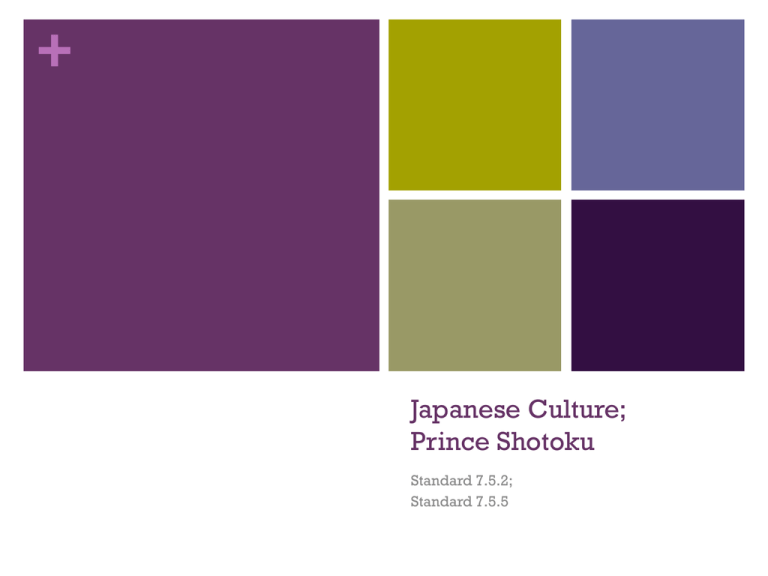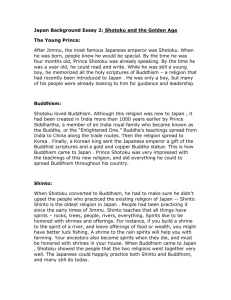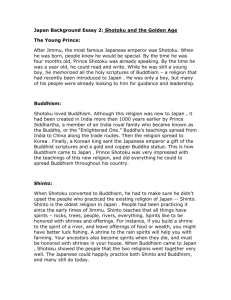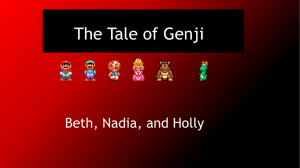11.8.12 Japanese Culture and Society - MGuenther
advertisement

+ Japanese Culture; Prince Shotoku Standard 7.5.2; Standard 7.5.5 + Today’s Standards 7.5.2 – Discuss the reign of Prince Shotoku and the characteristics of Japanese society and family life during his reign. 7.5.5 – Study the ninth and tenth centuries golden age of literature, art, and drama, including Lady Murusaki’s Tale of Genji + Vocabulary Set 2: Imperial Court - Regent (Ex: Prince Shotoku) – Taika Reforms – Haiku - Noh – Tale of Genji (by Lady Murusaki Shikibu) - + Imperial Court Definition: The extended household of the ruler as well as people who regularly served the ruler. Significance: As well as being the center of political life, imperial courts were usually the drivers of new trends in fashion, literature, music, and art. Who are the courtiers (people attending the court)? Officials or servants employed by the ruler Nobles attending in hope of political or financial gain Other nobles attended for the culture and entertainments offered. + Regent (Prince Shotoku r. 593-622) Definition: A person who rules in place of a monarch who is underage, absent, or incapacitated. Significance: Prince Shotoku was a regent whose desire to emulate Chinese culture greatly influenced Japan’s development. Promotes Buddhism and Confucianism Seventeen Article Constitution (set of laws/principles how a state should be governed) Promotes a strong central government imperial state modeled like China’s + Taika Reforms Definition: A series of reforms introduced (after Shotoku’s death) aimed to make the Japanese central government stronger by organizing it like China’s imperial state. (Reform = to make changes to something to improve it) Significance: Land became public property “public” meaning owned by the emperor The reforms ultimately failed because the aristocracy (powerful nobles and courtiers) resisted and were too powerful + Haiku Definition: A Japanese form of poetry consisting of 3 lines and 17 syllables (5, 7, 5) Significance: Haiku poems reflected Japanese society’s emphasis on sadness, rejected love, or the beauty of nature. Example: An old silent pond… Into the pond a frog jumps; splash! Silence again. -Matsuo Basho + Noh Definition: A Japanese theatrical tradition where masked actors play out themes from Shinto mythology. Shinto = Traditional Japanese religion –respect nature, spirits, etc Significance: Noh drama was a distinctive Japanese form of drama using masks to portray emotion. Men were the actors. Both nobles and commoners enjoyed Noh drama. + Tale of Genji by Lady Murasaki Shikibu Definition: A book about the life of a prince in the imperial court. Significance: The biggest literary achievement in Japan—the first novel (a long written story)! Before this, books were just retellings of myths or short stories RealisticHuman experiences and emotion (sadness mostly) + Influence of China and Korea on Japan Korean travelers and missionaries first brought ideas from the Chinese civilization to Japan. Later, groups of Japanese went to China to study its culture for themselves. The Japanese adapted features from China to make them part of their own culture. Copy the graphic organizer on the following slide. Using your book (page 252) and/or your notes describe how the Japanese adapted Chinese beliefs in each of the 5 categories provided. Adopted Confucian ideals Landscape painting, + Reading Questions: Page 258-261 1. What characteristics do Chinese and Japanese writing share? 2. Why was The Tale of Genji a significant literary achievement? 3. Picture on pg. 258: What characteristics of Kabuki does this image show? 4. How do Japanese calligraphers express meaning through their writing? 5. What are the subjects of Japanese brush paintings? 6. What was the aim of Japanese gardeners and flower arrangers? + Reading Questions: Page 258-261 1. What characteristics do Chinese and Japanese writing share? Both use characters to stand for specific things, actions or ideas. 2. Why was The Tale of Genji a significant literary achievement? It was the world’s first novel—long, realisitic story centered around one character. 3. Picture on pg. 258: What characteristics of Kabuki does this image show? Heavy makeup, elaborate costume. 4. How do Japanese calligraphers express meaning through their writing? They change the sizes and shapes of the characters they write. 5. What are the subjects of Japanese brush paintings? Landscapes, historical events, scenes from daily life. 6. What was the aim of Japanese gardeners and flower arrangers? To show the beauty of nature and create a peaceful space.











